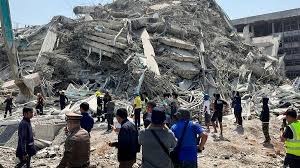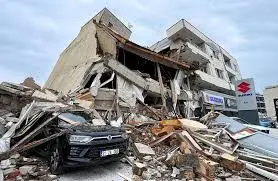Advertisements
The safety of our homes is an undisputed priority, especially when it comes to natural threats like earthquakes. Many cities around the world are located in seismic zones, and it's crucial to be informed about the level of risk to which we are exposed.
In this content, we'll explore how to identify if your city is vulnerable to earthquakes, providing essential information that could be vital to your family's safety. You'll also learn effective strategies to prepare your home for any seismic event.
Advertisements
From properly securing furniture to creating a family emergency plan, every detail counts when it comes to minimizing risks and protecting what we value most.
We'll also discuss the technological tools available that can provide early warnings and how to use them to our advantage. Staying informed and prepared not only increases safety but also provides peace of mind in times of uncertainty.
Advertisements

Understanding seismic risk in your city
Earthquakes are unpredictable natural phenomena that can have devastating consequences. Understanding your city's seismic risk is the first step to protecting your home and family.
To assess this risk, it is essential to understand the region's historical seismic activity, as well as its proximity to active tectonic faults. Seismic monitoring agencies and geological institutes often provide risk maps indicating the areas most likely to be hit by an earthquake.
Furthermore, the type of soil and geological characteristics of the area can significantly influence the intensity of an earthquake. Areas with soft soils or high sediment concentrations may experience greater shaking, increasing the risk of structural damage.
Therefore, it's crucial to research and understand the specifics of the terrain your home is located on. Consulting with geology and civil engineering experts can provide a deeper understanding of the risks specific to your city.
These professionals can offer advice on how to reinforce existing structures or design new buildings to comply with current seismic regulations.
Earthquake Planning and Preparation
Preparation is key to minimizing the impact of an earthquake. A well-structured emergency plan can save lives and reduce chaos during and after a seismic event. Start by developing a family communication plan that includes a safe meeting place and emergency contacts. Make sure all family members are familiar with the plan and conduct regular drills. Additionally, it's essential to have a well-stocked emergency kit in an accessible location. This kit should contain basic supplies such as drinking water, non-perishable food, flashlights, batteries, a first aid kit, and copies of important documents. Also consider including warm clothing and basic tools for emergency situations. Also, make sure furniture and large appliances are securely fastened to the walls to prevent accidents during an earthquake. Small preventative actions can make a big difference in the safety of your home.
Structural safety measures in your home
Structural safety is crucial to protecting a building's occupants during an earthquake. If you live in a high-risk seismic zone, consider having your home structurally assessed by a civil engineer specializing in seismology. This professional can identify vulnerabilities in the building and suggest necessary improvements or reinforcements. Implementing measures such as reinforcing walls, beams, and columns can significantly increase a structure's resistance to seismic forces. Furthermore, using appropriate building materials and complying with local building regulations are essential to ensuring a building's safety. It's important to remember that not only residential structures must be reinforced, but also critical infrastructure such as schools, hospitals, and government buildings. A well-prepared community is one that ensures the safety of all its citizens, not just in their homes.
Appropriate reaction during an earthquake
Knowing how to react appropriately during an earthquake can make the difference between safety and danger. If an earthquake occurs while you are inside a building, follow the "drop, cover, and hold on" rule. Take shelter under a sturdy table or against an interior wall, away from windows and objects that could fall. Stay there until the shaking ends. If you are outside, look for an open space away from buildings, trees, and power lines. Stay calm and avoid running, as panic can lead to accidents. If you are driving, stop your vehicle safely on the side of the road and remain inside until the shaking passes. After the earthquake, make sure all family members are safe and check your home for possible structural damage. If you detect gas or water leaks, turn off the supply immediately and report the incident to the appropriate authorities.

Importance of education and awareness
Education and awareness are essential to creating a culture of seismic prevention. Schools and communities should implement educational programs that teach children and adults about seismic risks and how to properly prepare. Participating in earthquake drills and educational activities can help reduce fear and ignorance about these natural phenomena. Furthermore, it is important to stay informed through reliable sources about the latest developments in seismology and safety measures. Local and national authorities often offer up-to-date resources and guides to help citizens prepare for any eventuality. Prevention and preparedness are not only individual responsibilities, but also community responsibilities. Collaborating with neighbors and local organizations can strengthen the entire community's resilience to an earthquake.
Community Resources and Support
Having a community support network is vital to effectively dealing with the aftermath of an earthquake. Nonprofit organizations, neighborhood groups, and government agencies can provide resources and assistance to affected communities. It is crucial for citizens to know what resources are available and how to access them in the event of an emergency. Communities should work together to develop contingency plans that include identifying temporary shelters, creating food banks, and organizing rescue and first aid teams. These measures not only promote solidarity but also strengthen disaster response capacity. Engaging in community activities and participating in emergency planning can increase social cohesion and ensure that all community members are better prepared to face an earthquake.

Conclusion
- Evaluate the seismic risk of the city
- Develop a family emergency plan
- Reinforce the structural security of the home
- Practicing appropriate reactions during an earthquake
- Promote earthquake education and awareness
- Establish community support networks







